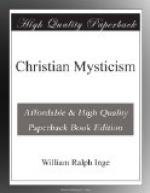[Footnote 246: Other scholastics and mystics had taught that there is a residue of the Godlike in man. The idea of a central point of the soul appears in Plotinus and Augustine, and the word scintilla had been used of this faculty before Eckhart. The “synteresis” of Alexander of Hales, Bonaventura, Albertus Magnus, and Thomas Aquinas, was substantially the same. But there is this difference, that while the earlier writers regard this resemblance to God as only a residue, Eckhart regards it as the true Wesen of the soul, into which all its faculties may be transformed.]
[Footnote 247: The following passage from Amiel (p. 44 of English edition) is an admirable commentary on the mystical doctrine of immanence:—“The centre of life is neither in thought nor in feeling nor in will, nor even in consciousness, so far as it thinks, feels, or wishes. For moral truth may have been penetrated and possessed in all these ways, and escape us still. Deeper even than consciousness, there is our being itself, our very substance, our nature. Only those truths which have entered into this last region, which have become ourselves, become spontaneous and involuntary, instinctive and unconscious, are really our life—that is to say, something more than our property. So long as we are able to distinguish any space whatever between the truth and us, we remain outside it. The thought, the feeling, the desire, the consciousness of life, are not yet quite life. But peace and repose can nowhere be found except in life and in eternal life, and the eternal life is the Divine life, is God. To become Divine is, then, the aim of life: then only can truth be said to be ours beyond the possibility of loss, because it is no longer outside of us, nor even in us, but we are it, and it is we; we ourselves are a truth, a will, a work of God. Liberty has become nature; the creature is one with its Creator—one through love.”]
[Footnote 248: No better exposition of the religious aspect of Eckhart’s doctrine of immanence can be found than in Principal Caird’s Introduction to the Philosophy of Religion, pp. 244, 245, as the following extract will show: “There is therefore a sense in which we can say that the world of finite intelligence, though distinct from God, is still, in its ideal nature, one with Him. That which God creates, and by which He reveals the




